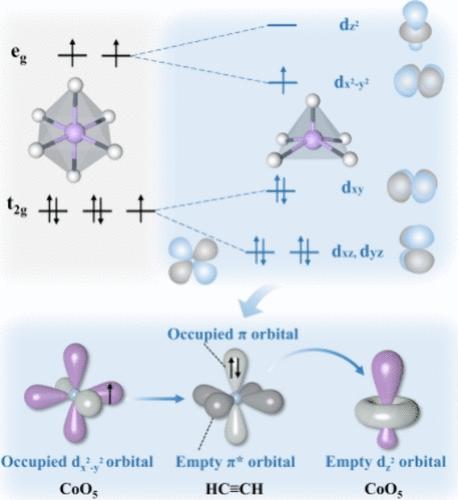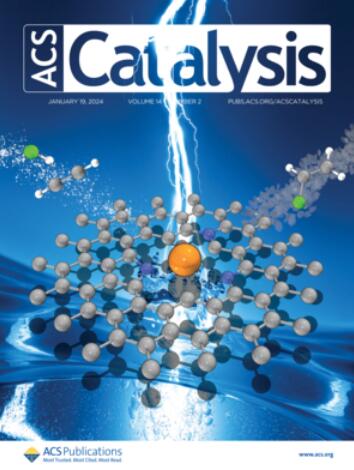Disrupted Spin Degeneracy Promoted C≡C Triple Bond Activation for Efficient Electrochemical Acetylene Semihydrogenation
IF 13.1
1区 化学
Q1 CHEMISTRY, PHYSICAL
引用次数: 0
Abstract
Disrupting the spin degeneracy of the electrocatalyst and further manipulating the related orbital electron arrangement are highly desirable for activating acetylene molecules. Herein, a squarate cobalt-based metal–organic framework (Co-MOF) ([Co3(C4O4)2(OH)2]·3H2O) is post-treated to accelerate the evolution from CoO6 octahedron to CoO5 pentahedron and further utilized for the electrochemical acetylene semihydrogenation reaction. Comprehensive analyses corroborate that the disrupted spin degeneracy of active sites originated from the breakage of the Co–O bond, which promotes the cleavage of the orbital energy level and the rearrangement of the d-orbital electron. The newly emerged half-occupied dx2–y2 orbitals and empty dz2 orbitals in CoO5 pentahedron concerted interplay with the bonding and antibonding orbitals of acetylene, which reduces the adsorption energy of acetylene and facilitates the activation of the inert C≡C triple bond. Thus, the defective Co-MOF exhibits the superior ethylene Faradaic efficiency of 96% and partial current density of 128 mA cm–2 at −1.0 V vs RHE compared to that of pristine Co-MOF (FEC2H4: 60%; JC2H4: 66 mA cm–2). This work delivers inspiration for spin-state regulation of active sites and sparks renewed interest in designing highly efficient electrocatalysts.

中断自旋简并促进C≡C三键激活高效乙炔半氢化反应
破坏电催化剂的自旋简并并进一步操纵相关的轨道电子排列是激活乙炔分子非常需要的。本文对方形钴基金属有机骨架(Co-MOF) ([Co3(C4O4)2(OH)2]·3H2O)进行后处理,加速CoO6八面体向CoO5五面体的演化,并进一步用于电化学乙炔半加氢反应。综合分析证实,活性位点的自旋简并破坏源于Co-O键的断裂,这促进了轨道能级的解理和d轨道电子的重排。CoO5五面体中新出现的半占位的dx2-y2轨道和空的dz2轨道与乙炔的成键轨道和反键轨道相互作用,降低了乙炔的吸附能,有利于惰性的C≡C三键的活化。因此,与原始Co-MOF相比,缺陷Co-MOF在−1.0 V vs RHE下的乙烯法拉第效率为96%,分电流密度为128 mA cm-2 (FEC2H4: 60%;JC2H4: 66 mA cm-2)。这项工作为活性位点的自旋状态调节提供了灵感,并激发了设计高效电催化剂的新兴趣。
本文章由计算机程序翻译,如有差异,请以英文原文为准。
求助全文
约1分钟内获得全文
求助全文
来源期刊

ACS Catalysis
CHEMISTRY, PHYSICAL-
CiteScore
20.80
自引率
6.20%
发文量
1253
审稿时长
1.5 months
期刊介绍:
ACS Catalysis is an esteemed journal that publishes original research in the fields of heterogeneous catalysis, molecular catalysis, and biocatalysis. It offers broad coverage across diverse areas such as life sciences, organometallics and synthesis, photochemistry and electrochemistry, drug discovery and synthesis, materials science, environmental protection, polymer discovery and synthesis, and energy and fuels.
The scope of the journal is to showcase innovative work in various aspects of catalysis. This includes new reactions and novel synthetic approaches utilizing known catalysts, the discovery or modification of new catalysts, elucidation of catalytic mechanisms through cutting-edge investigations, practical enhancements of existing processes, as well as conceptual advances in the field. Contributions to ACS Catalysis can encompass both experimental and theoretical research focused on catalytic molecules, macromolecules, and materials that exhibit catalytic turnover.
 求助内容:
求助内容: 应助结果提醒方式:
应助结果提醒方式:


